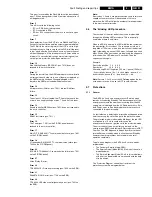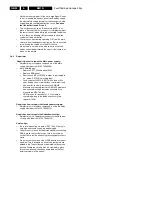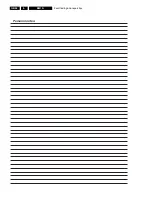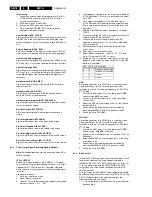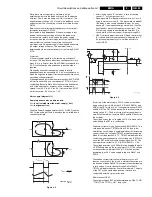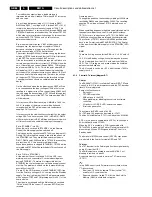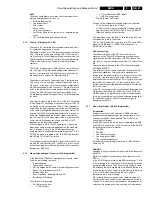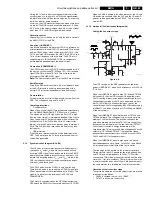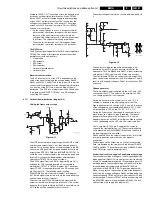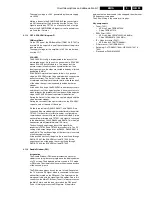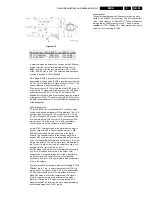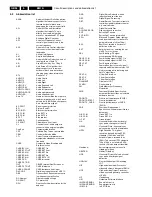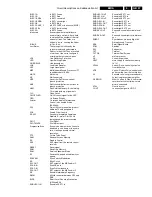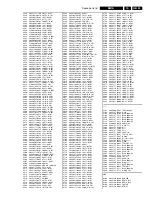
Circuit descriptions and abbreviation list
GB 85
EM1A
9.
Since there are no capacitors and there is a high
amplification-factor in the feedback circuit, the feedback is
ultra-fast. This is why the ripple on UOUT is minimal. The
negative supply voltage (-20 V) used in the feedback circuit
originates from the co-coupling coil and is rectified through
D6103.
Stabilisation is not effected through duty-cycle control but
through burst-mode of TS7100.
Burst-mode is load dependent. If the power supply is less
loaded, the secondary voltage will have the tendency to
increase more rapidly. If the load on the power supply
increases, then the oscillator stops less often, right up to the
moment that the oscillator is operating continuously:
maximum load. If the power supply is now loaded even more,
the output voltage will decay. The maximum load is
determined by the maximum primary current set by R3108//
3118.
Protection:
If the optocoupler would fail, the secondary voltage will
increase. This would have disastrous consequences since
many IC's (e.g. Painter, flash-RAM, DRAM) are fed with this
5.2 V. In other words, very expensive repairs would be
required.
We already know that the negative supply is directly
dependent upon the secondary 5.2 V, as a consequence of
which the negative supply will increase proportionally as the
secondary voltage increases.
If the negative supply in the mean time reaches -30 V, D6106
will start to zener and as a consequence TS7101 will start
conducting. Basically, D6106 will take over the stabilisation
task of the optocoupler, however, with a considerable
spread: from -20 V to -30 V is a 50 % increase, thus UOUT
will increase from 5.2 V to max. 7.5 V.
Main supply (diagram A1)
Some important notes on beforehand:
V
BAT
is not isolated from the mains supply ('hot').
V
BAT
is alignment free.
The Main Power Supply generates the 141 V (VBAT) and the
28 V for the audio part, and is based on the so-called 'down
converter' principle.
Figure 9-5
•
After closing switch 'S', the linear in time increasing
current IT, , will charge capacitor C.
•
Opening switch 'S' will generate a counter-e.m.f. in coil L,
trying to maintain current IT. This is possible via diode D
(this diode is also called 'freewheel diode'). So after
opening 'S', the magnetic energy stored in coil L will be
transferred to electrostatic energy in capacitor C. The
VIN will only supply current during the time that 'S' is
closed while a constant current is flowing through RL.
•
VBAT is directly proportional with VIN and the time that
'S' is closed and reverse proportional with period time 'T'.
So by changing the duty cycle, it will be possible to
control VBAT.
Figure 9-6
At start-up of the main supply, C2515 can be assumed as
being a shortcircuit. UAB will be 15 V (R3513, D6510) and
UGS of the FET will be +5.4 V (voltage division over R3512
and R3518). The FET will be driven into saturation (same as
closing switch 'S' ). The drain-current will increase linear in
time. With other words: resistors R3513 and R3518 will start
the oscillator.
The voltage across the co-coupled coil (4, 5) is also positive
and will keep the FET into conductivity.
The drain-current will also flow through R3514//R3515. The
voltage on the base of TS7502 will be +0.8 V due to the
stabilisation circuit (which is explained further). At increasing
current, the emitter-voltage of TS7502 will get more negative.
When this voltage reaches -0.7 V, TS7502 will be driven into
conductivity and consequently connect the gate of TS7504 to
earth; the FET will block (same as opening switch 'S'). The
maximum drain-current is: 0.7 V/(R3514//R3515) = 1.4 A.
The voltage polarities on L5506 will invert, keeping the gate
of TS7504 negative via the co-coupled coil (4, 5). The voltage
on the secondary winding of L5506 (7, 8) will be positive,
generating the +28 V audio supply voltage via D6507 and
C2512.
The sudden current interruption in the primary coil, will
induce a counter-e.m.f. that wants to maintain the current via
the 'freewheel' diode D6508. This current is linear decreasing
in time and as it is also flowing through R3414//R3415,
TS7502 will be blocked after a certain time period. The gate
of the FET will be again made positive, is driven into
conductivity and the cycle starts again.
Stabilisation of VBAT:
The output voltage VBAT will be determined by: VBAT = VIN
* TON/(TON + TOFF) = VIN * duty-cycle.
96532156_022.eps
060100
R
L
I
T
I
T
V
BAT
Vin
S
C
L
R
L
I
D
I
D
V
BAT
Vin
S
C
L
Sclosed
Sopen
δ
T
V
IN
.
δ
T
T
+
+
D
D
VBAT =
T
CL 96532156_014.eps
210100
3513
A
B
3518
120K
1503
3511
3508
3504
D
S
G
7504
I
D
3512
68K
R
LOAD
1502
6507
6510
15V
6505
15V
2503
5506
5506
5505
6508
5
4
7
8
3
1
V
BAT
2515
2512
6506
7502
3514
3515
V
S
T
OFF
T
OFF
0
-1.4V
UR3514
U
in
t
-0.7V
t
V
GS
+12V
V
GS
ca 10
µ
s
UMAINS
180V
i.s.o. 240V
COLD
HOT
(28V)

